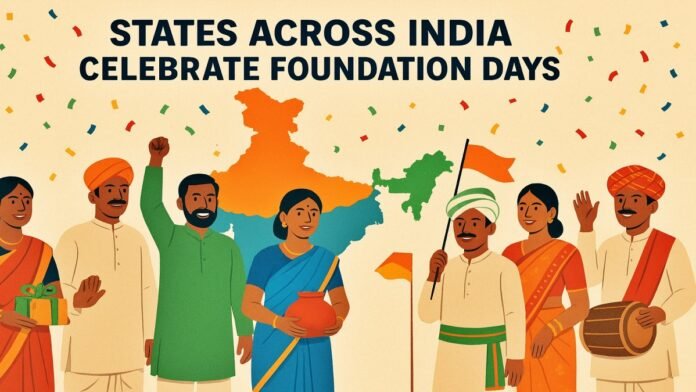
Key Points
- President Murmu, PM Modi, and Union Ministers celebrate foundation days of Chhattisgarh, Madhya Pradesh, Haryana, Kerala, Karnataka, and Andhra Pradesh
- Union Home Minister Amit Shah sets March 31, 2026 deadline to completely eliminate Naxalism from Chhattisgarh
- PM Modi highlights transformation of former Naxal-affected areas into development hubs
- Leaders emphasize unique cultural identities: Haryana’s valor, Madhya Pradesh’s heritage, Karnataka’s innovation
- Article 3 of Constitution grants Parliament power to reorganize state boundaries through legislative process
New Delhi: Multiple Indian states marked their foundation days on Saturday, November 1, 2025, with President Draupadi Murmu, Prime Minister Narendra Modi, and senior BJP leaders extending greetings while highlighting each state’s unique contributions to the nation’s progress and cultural tapestry.
Chhattisgarh: Mission to End Red Terror by 2026
Union Home Minister Amit Shah used Chhattisgarh’s foundation day celebrations to announce an ambitious deadline for eradicating Naxalism from the tribal-rich state. Speaking about the decades-old insurgency that has hindered the state’s development potential, Shah declared that both central and state governments remain fully committed to eliminating the menace.
“Naxalism is breathing its last in the country,” Shah asserted, setting March 31, 2026, as the target date for eliminating what he termed “red terror” from Chhattisgarh. He emphasized that achieving this goal would usher in a transformative era of development for the state, known for its rich tribal culture and traditional arts.
Prime Minister Modi reinforced this message, noting the dramatic transformation already underway. “Many areas once affected by Naxalism are now competing for development,” Modi stated, highlighting the positive changes in formerly insurgency-affected regions.
The Chhattisgarh government has intensified security operations in recent months, combining improved infrastructure development with targeted anti-Naxal campaigns to win over local populations in affected districts.
Historical Significance: Chhattisgarh’s Seven-Decade Journey
Chhattisgarh, celebrating its 25th foundation day in 2025, achieved statehood on November 1, 2000, after being carved out from Madhya Pradesh through the Madhya Pradesh Reorganisation Act. The demand for separate statehood first emerged in the 1920s during the Raipur Congress unit meeting in 1924, making it one of India’s longest-running statehood movements.
The movement gained significant momentum in the 1990s with the formation of the Chhattisgarh Rajya Nirman Manch, led by Chandulal Chandrakar, which organized successful region-wide strikes and rallies supported by major political parties, including the Indian National Congress and Bharatiya Janata Party. The bill received unanimous approval from the Madhya Pradesh Assembly before being passed in both houses of Parliament, with President K.R. Narayanan giving consent on August 25, 2000.
Ajit Jogi became the first Chief Minister of the newly formed state, which was created primarily to ensure better governance for the region’s tribal population and address administrative challenges faced under the larger Madhya Pradesh administration. Notably, Chhattisgarh’s statehood was achieved without any violence, representing a significant milestone in India’s democratic and federal journey.
Haryana: Land of Warriors and Farmers
Leaders showered praise on Haryana for its dual identity as a state producing both valorous soldiers and industrious farmers. Amit Shah described Haryana as currently setting new benchmarks in good governance and public welfare schemes.
Prime Minister Modi elaborated on Haryana’s multifaceted contributions, describing it as an exemplar of farmers’ tireless hard work, soldiers’ incomparable valor, and youth’s extraordinary achievements in sports and other fields. The state has consistently produced Olympic medalists and contributes significantly to India’s agricultural output while maintaining strong representation in the armed forces.
Historical Significance: Haryana’s Linguistic Reorganisation
Haryana came into existence on November 1, 1966, as India’s 17th state through the Punjab Reorganisation Act, following linguistic reorganization that separated Hindi-speaking regions from Punjabi-speaking areas. The Indian government established the Shah Commission under Justice J.C. Shah on April 23, 1966, to determine the boundaries of the new state based on languages spoken by the people.
The commission delivered its report on May 31, 1966, recommending that the then-districts of Hisar, Mahendragarh, Gurgaon, Rohtak, and Karnal, along with tehsils of Jind, Narwana, Naraingarh, Ambala, and Jagadhri, would form the new state. Chandigarh was designated as a union territory, serving as the joint capital of both Punjab and Haryana.
Dharamvir was appointed as Haryana’s first Governor, while Bhagwat Dayal Sharma became the first Chief Minister. Chaudhary Devi Lal is credited as the instrumental figure who pushed for the creation of this commission and the separation of Haryana from Punjab in 1966.
Madhya Pradesh: Cultural Heart of India
Madhya Pradesh received recognition as India’s cultural and geographical heart. Union Home Minister Shah praised the state’s exceptional natural beauty, deep-rooted cultural heritage, and rich historical legacy. He expressed hopes that Madhya Pradesh continues its trajectory toward enhanced public welfare, cleanliness initiatives, and economic prosperity.
The state’s central location and diverse cultural traditions make it a crucial link connecting different regions of India, while its historical monuments and tribal cultures add to the nation’s heritage wealth.
Historical Significance: Madhya Pradesh’s Complex Unification
Madhya Pradesh was formed on November 1, 1956, marking its 69th foundation day in 2025, through the consolidation of Central Provinces and Berar with the princely states of Madhya Bharat, Vindhya Pradesh, and Bhopal under the States Reorganisation Act of 1956. Before independence, Central India was a mosaic of princely states with varying degrees of power and autonomy under British rule, including the powerful Scindia dynasty of Gwalior and the Nizam of Bhopal.
Although the State Reorganisation Commission had recommended Jabalpur as the capital, Bhopal was ultimately chosen instead, marking November 1, 1956, as the official formation day of modern Madhya Pradesh. The Marathi-speaking districts of Vidarbha were separated from Madhya Pradesh and merged with Bombay State, leaving behind a predominantly Hindi-speaking state.
The evolution of Madhya Pradesh continued beyond 1956, with 19 districts being split between 1951 and 2021 to create 20 new districts, and eight districts having their names changed. This massive state later underwent another significant reorganization when Chhattisgarh was carved out in 2000.






















































